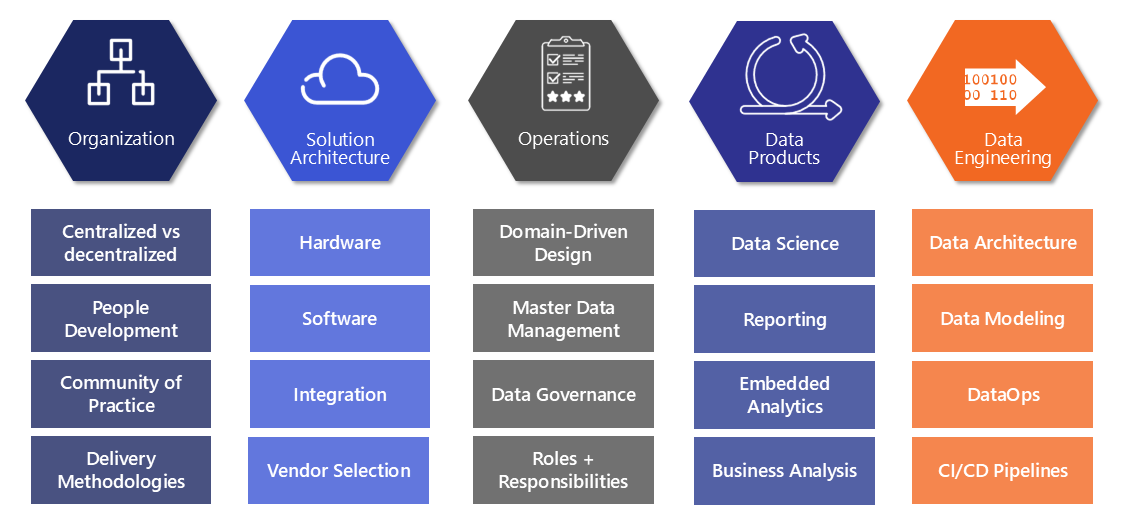8-minute read
Quick summary: How an effective end-to-end data strategy transforms data into a strategic asset, aligning with business goals to drive insights, innovation, and long-term competitive advantage
Data has become one of the most valuable assets for modern organizations, driving strategic decisions, customer insights, and operational efficiencies. To harness data’s power to its fullest extent, companies need more than scattered data collection and analysis efforts. They need a comprehensive, end-to-end data strategy that enables them to turn raw data into a competitive advantage that aligns with broader business goals.
Yet, many businesses encounter pitfalls when defining and executing their data strategy. Disjointed efforts, overly technology-centric approaches, and a narrow focus that ignores organizational objectives often lead to underwhelming results, missing the full potential of data to transform the business. An effective data strategy addresses these challenges with a holistic framework that aligns data initiatives with organizational goals, unlocking the full potential of data to deliver impactful outcomes.
In this article, we’ll explore the importance of an enterprise data strategy, common challenges that organizations face, and a data strategy framework to align improvement initiatives. Our end-to-end framework enables leaders to evaluate and refine their data practices to meet evolving business needs and drive impactful results.
To harness data’s power to its fullest extent, businesses need a comprehensive, end-to-end data strategy that enables them to turn raw data into a competitive advantage that aligns with broader business goals.
Purpose and scope of an end-to-end-data strategy
An end-to-end data strategy is a comprehensive plan that guides the entire data lifecycle—from initial collection and storage to ongoing management, sharing, and usage. Unlike piecemeal approaches, which may focus only on a single technology or department, an end-to-end data strategy is built to align with the organization’s larger business goals. This alignment ensures data initiatives serve not just isolated projects, but the organization’s overarching objectives, making data a truly strategic asset.
What sets an end-to-end data strategy apart is its holistic nature. It goes beyond isolated technology implementations or single-use projects, integrating:
- Processes that standardize data development and governance across the organization
- Technology that supports scalable, accessible, and secure data practices
- People who are trained and empowered to use data effectively
By embedding data strategy within core business functions, organizations can move from reactive data efforts to proactive, value-driven insights that foster growth, drive innovation, and improve decision-making.
Common challenges with data strategy implementation
Implementing an effective data strategy is complex, and many organizations encounter recurring challenges that can hinder success. Addressing these challenges early on is crucial to building a sustainable, impactful data strategy.

Data strategy ambiguity
The term “data strategy” is often broadly defined, leading to confusion and a lack of focus. Without a shared understanding of what a data strategy should encompass, organizations may struggle to prioritize and unify their approach. Many mistakenly focus solely on technical components (data infrastructure, etc.), operations (data governance, etc.), regulatory commitments, or data literacy and culture. Without a comprehensive approach, significant gaps emerge, leaving the strategy incomplete and ineffective.
Misalignment with business goals
Data strategies frequently fail when they don’t integrate with the organization’s broader objectives. When data initiatives are siloed from strategic goals, they risk becoming isolated “passion projects” that do not drive meaningful impact. Data projects that lack direct alignment with business needs may struggle to gain buy-in and get appropriate funding, resulting in limited adoption and underwhelming results. Identifying and aligning on measurable business objectives is essential to show organizational success and secure continued funding.
Organizational silos
Organizational silos further complicate the implementation of a cohesive data strategy. When different departments control isolated pockets of data, the organization cannot realize the full value of its data. Fragmented data ownership creates challenges in gaining a unified view of the business, and insights may be inconsistent or incomplete. Without cross-functional standards, data initiatives may lack the cohesion needed to generate impactful insights, leading to missed opportunities for innovation and operational efficiency.
Resistance to change
Resistance to change poses a significant challenge, as implementing a data strategy often requires shifts in both mindsets and workflows. Employees and leaders may be reluctant to adopt new, data-driven approaches due to concerns about losing control, lack of understanding, new responsibilities, or skepticism from previous initiatives that fell short of expectations.
To overcome this barrier, fostering a data-positive culture and emphasizing the value of data-driven approaches are essential. Clear communication, training, and showcasing early successes can build trust and support for new systems and processes.
Example problem: The infrastructure-only approach
For a hypothetical example, consider an organization that invests heavily in sophisticated data infrastructure, acquiring advanced storage and processing systems. However, they overlook the processes and governance structures needed to ensure data quality, security, and usability.
Without these foundational elements, data remains fragmented, data quality issues go unaddressed, and the organization struggles to derive actionable insights from its data—ultimately missing out on the value of its investment. Several years after the investment, the senior leadership team does not see appropriate ROI and questions future data investments. This scenario illustrates how neglecting a unified, holistic approach can lead to an ineffective data strategy, despite the availability of significant resources.
Core components of a successful data strategy
A well-rounded data strategy encompasses a series of core components that work together to ensure data is collected, stored, processed, and used effectively across the organization. While priorities and execution may shift over time in response to evolving business needs, it’s essential to establish and maintain a baseline capability in each core area.

Our data strategy framework complements the classic “people, process, and technology” model to ensure strategy is implemented effectively across the entire data lifecycle.
1. Organization
This often-overlooked component is one of the first things to evaluate when missing ROI expectations.
- Centralized versus decentralized: An early decision needs to be made about centralizing all data activities in a large IT team or enabling business teams to drive their own insights. Core components to consider are challenges in standardization, speed to delivery, and current team skills.
- People development: Given the rapid pace of change in the data world, it is important to dedicate investments—of both time and budget—to ensuring all people (technical and business) have the necessary training, coaching, and opportunity to apply new skills.
- Community of Practice: The key to long-term sustainability is ensuring that core data builders and users can learn, share, and improve without direct investment or involvement from the central IT team. Establishing a Community of Practice ensures the wheels don’t fall off your investment by keeping people engaged.
- Delivery methodologies: There are lots of different methodologies (Kanban, product, data mesh, data fabric, etc.), each of which provides its own unique advantages. It is most important to ensure all teams understand the organization’s approach and have access to supporting materials.
2. Solution architecture
Many tech-focused individuals mistakenly equate solution architecture with the entire data strategy. While it is critical to performance—and a poorly designed solution can be very expensive in the future—the modern data solution is only one component of your data strategy.
- Hardware: Hardware is often going to come down to the cloud provider and any special use cases (ex. Gen AI needing GPU chips, security mandates, etc.). To remain competitive, hardware vendors must make large investments, so we recommend sticking with the large players (Amazon, Microsoft, Google) unless there is a unique need.
- Software: There are lots of different software options for managing your data, and each company will have its preferences. We recommend getting alignment on first foundations for software selection, ensuring it matches current and future team skills and offers flexibility for future change.
- Integration: The modern data stack has changed from being vendor specific to needing to mesh several “best of breed” software components. Ensuring consistent and scalable practices in integration will ensure all components can be effectively used.
- Vendor selection: The best vendors not only provide world-class solutions, but are also involved during all stages of development and adoption. We recommend assigning a dedicated person to manage the partnership.
3. Operations
“Operations” describes how the organization executes its data strategy. It is critical to be evaluating operations and adjusting them as the enterprise grows and becomes more data mature.
- Domain-driven design: Aligning around business domains can help clarify ownership and ensure the enterprise stays focused. This is critical if you are to pursue a data mesh architecture and scale data governance.
- Master data management: There are many different ways to execute MDM using centralized, decentralized, or hybrid approaches. There is no “golden” approach that will work for everyone, but clearly establishing standards and tools to monitor and remediate issues will jumpstart any data quality effort.
- Data governance: An effective data governance organization needs to balance rigor and enforcement of standards with the ability to remain agile in aligning with changing business needs. Data governance strategy will overlap several components of data strategy (e.g. operations, organization, solution architecture, etc.).
- Roles and responsibilities: Establishing processes with clear roles and responsibilities is critical to enabling the data strategy to scale. Evaluating enterprise needs and identifying any new gaps should be a routine activity driven by growth or operational KPIs (ex. SLAs, data governance, etc.).
4. Data products
Data consumers will be interacting with your data products on a daily basis. Adopting a product management mindset with Agile fundamentals will help keep users happy and engaged.
- Data science: Data science includes all things statistically driven at scale, including machine learning and AI. Focusing on sound testing and validation will ensure confidence in your AI products.
- Reporting: Building trust in reporting requires a strong understanding of which actions and decisions are influenced by reports. Sound data foundations help accelerate reporting development and make reports more robust in adapting to business change.
- Embedded analytics: Embedded analytics bring analytics to the workflow, creating a seamless experience where data can influence decision making. Whether analytics are internal or external facing, strong development practices are needed to ensure high availability.
- Business analysis: Business analysis is a capability that should be treated more like a product; strong business analysis should be driving all feedback loops for product development, from ideation to enhancement phases. Often only business analysis will suffice, without a full product needing to be developed.
5. Data engineering
Data engineering is the plumbing that ensures data can remain flowing for insight generation. Failures in data engineering can wreak havoc on trust and adoption of data across the organization.
- Data architecture: Data architecture provides the framework of how data is ingested, transformed, and shared across the organization. To ensure a flexible data architecture that can adjust to the ever-changing technology landscape, design should be rooted in the enterprise’s First Foundations for technology development.
- Data modeling: Data modeling provides the structures for data to be logically understood and to support both engineering and analytics activities. Models should translate real-world activities (including entities and relationships) into a data-friendly format that is organized in a meaningful and accessible way.
- DataOps: Data Operations focus on managing data workflows and assets, automating processes, and fostering collaboration across data and analytics teams. Strong DataOps accelerates development and is critical for teams to scale Agile processes.
- CI/CD pipelines: Continuous integration and continuous deployment pipelines are essential tools for automating development, testing, and deployment processes. CI/CD pipelines lower the risk of bad deployments, enable teams to scale, and decrease development time.
Now that you have an understanding of what your data strategy should encompass, we recommend evaluating your current maturity and identifying any gaps that need to be addressed. In a future article, we will go into detail on assessing your data strategy and best practices for long-term success.
If you would like a third-party assessment of your data strategy, feel free to contact me at MickW@logic2020.com and we’ll set up a discovery discussion.

Put your data to work for you
- Data strategy
- Data science
- Data engineering
- Visual analytics

Mick Wagner is responsible for leading the Advanced Analytics Practice to exceed client expectations, develop innovative solutions, and achieve organizational growth via the Logic20/20 Advanced Analytics offerings in Modern Data Platforms, Strategic Insights, and Data Science Excellence. Mick has over 15 years of data analytics consulting experience across the full BI lifecycle—defining data strategy and architecture, designing metadata-driven ETL frameworks, leading large teams in custom software development, developing data analytics, and defining KPIs across Fortune 100 and nonprofit clients.

